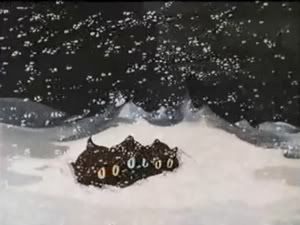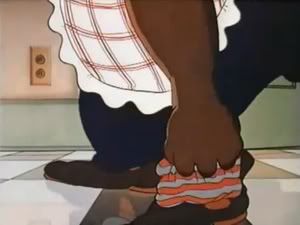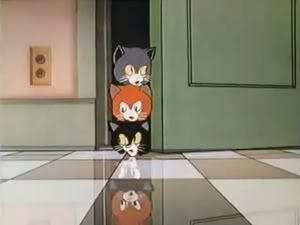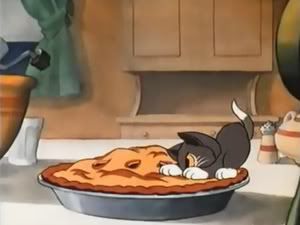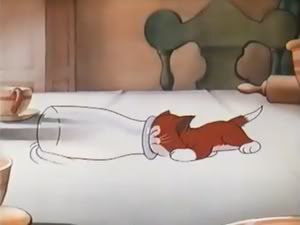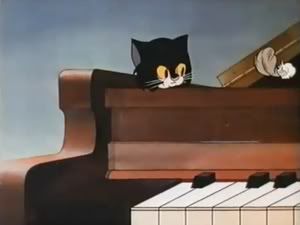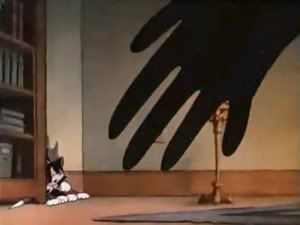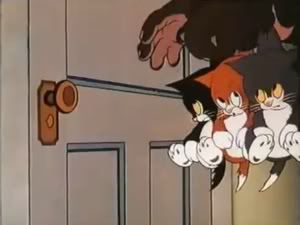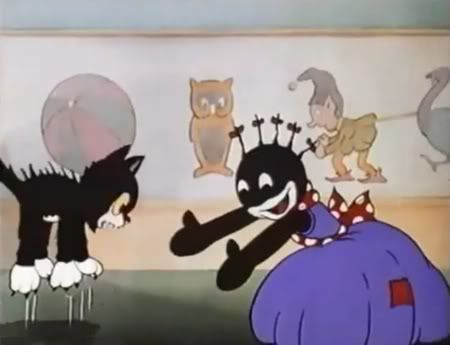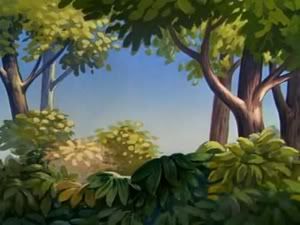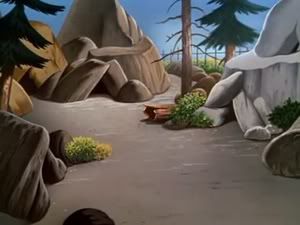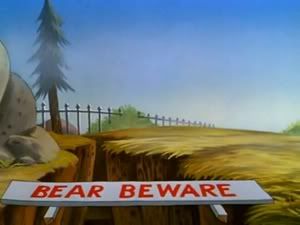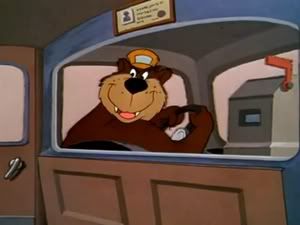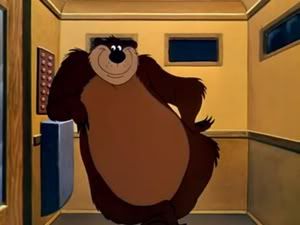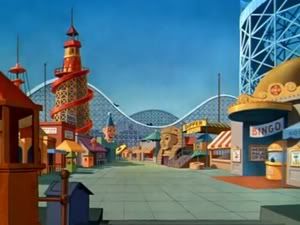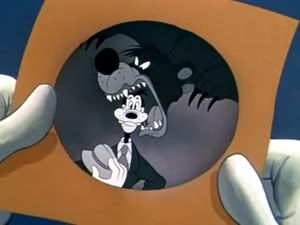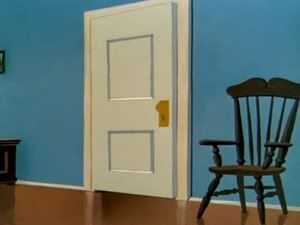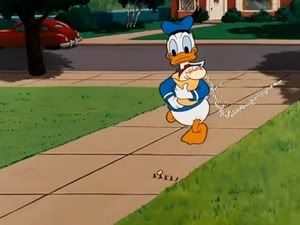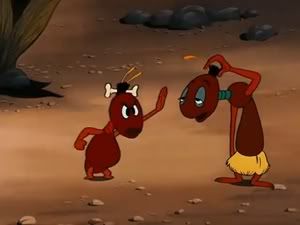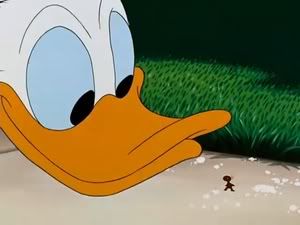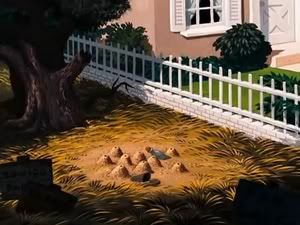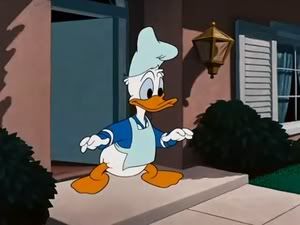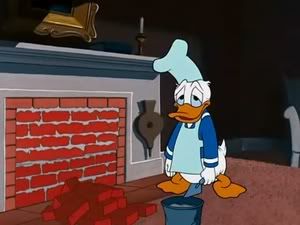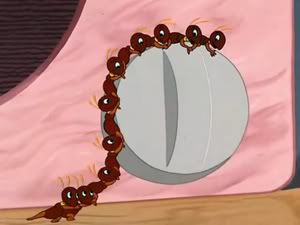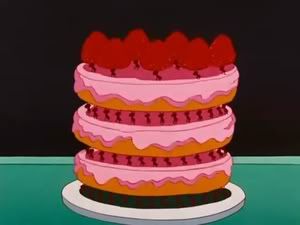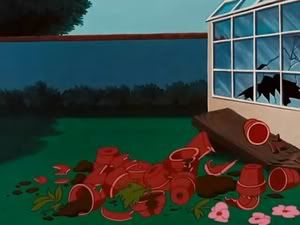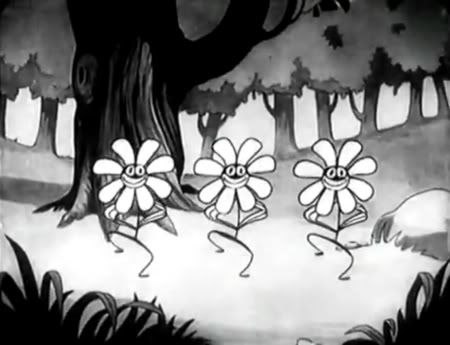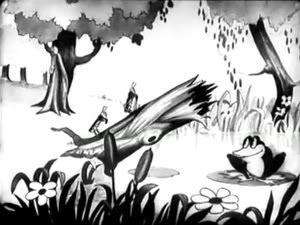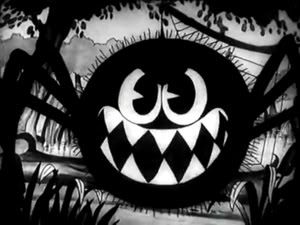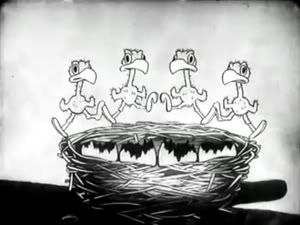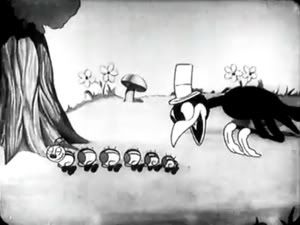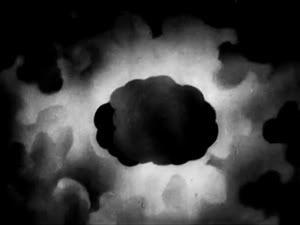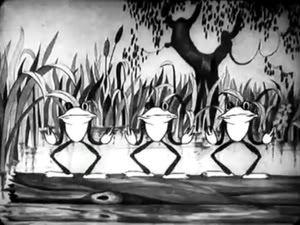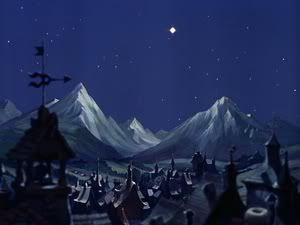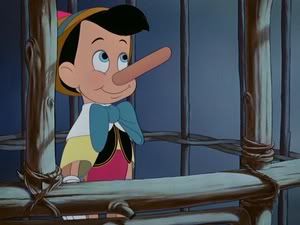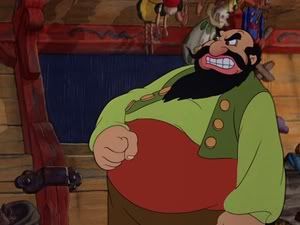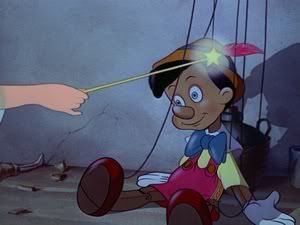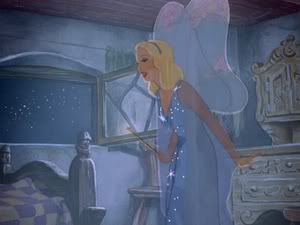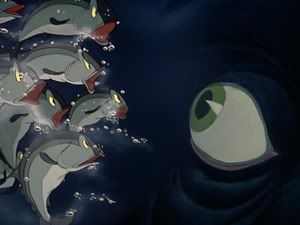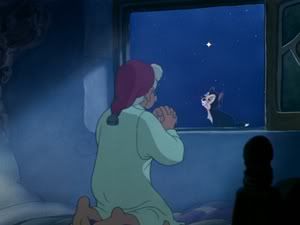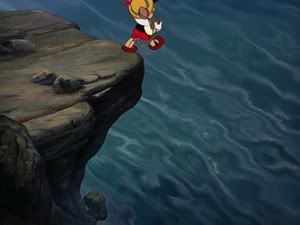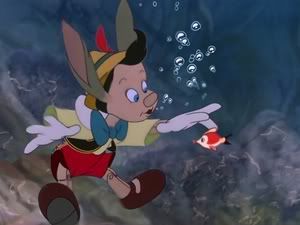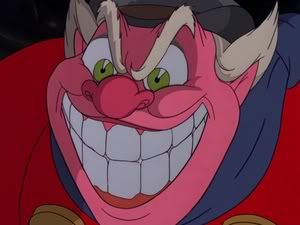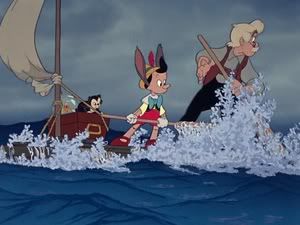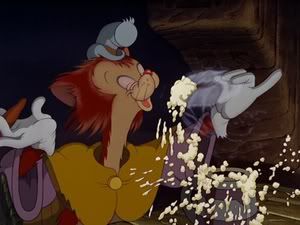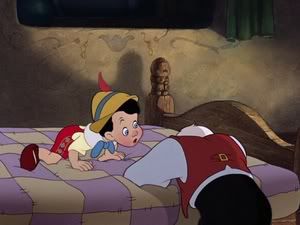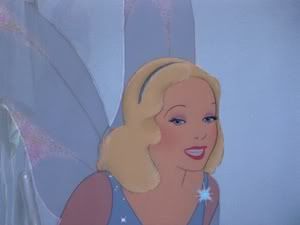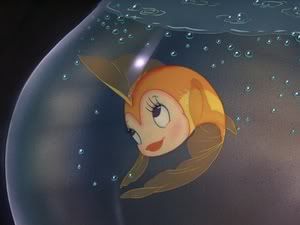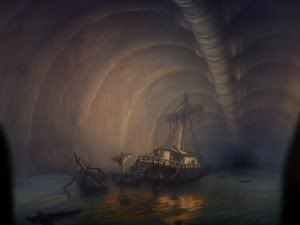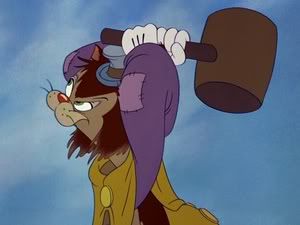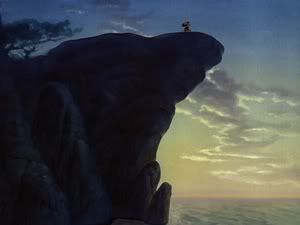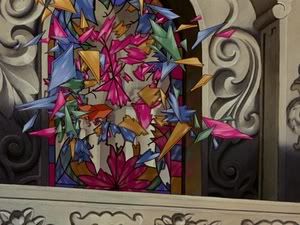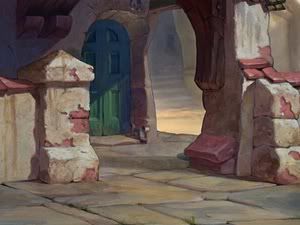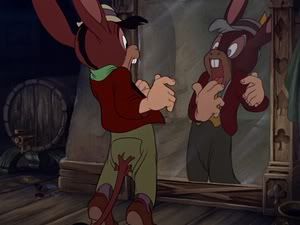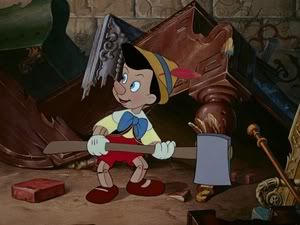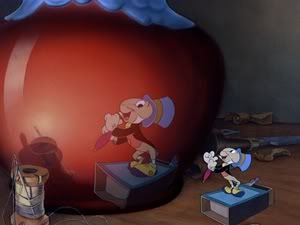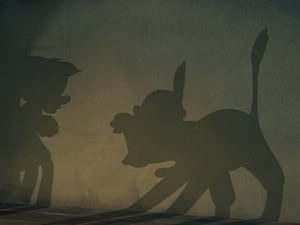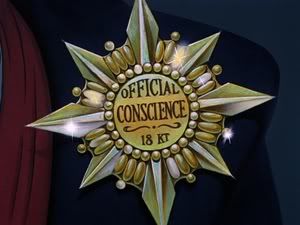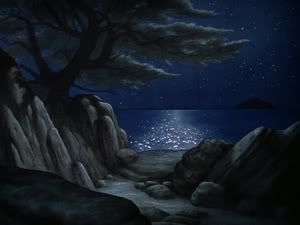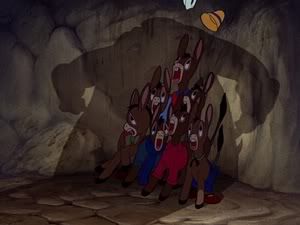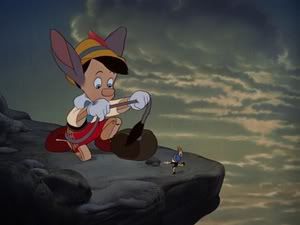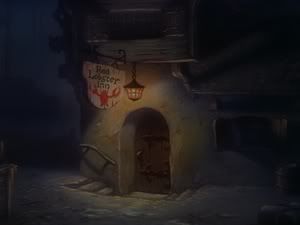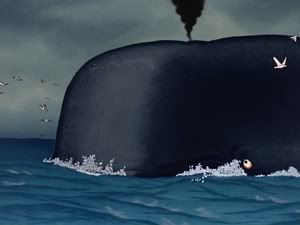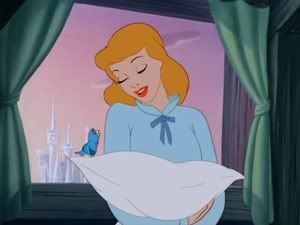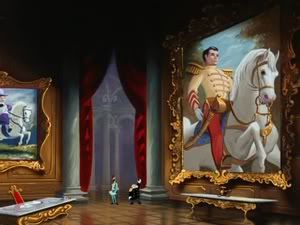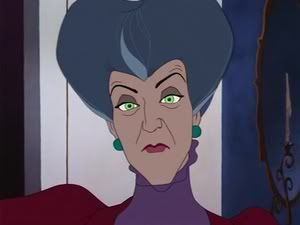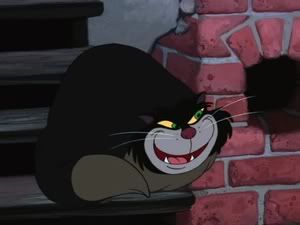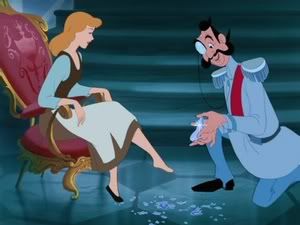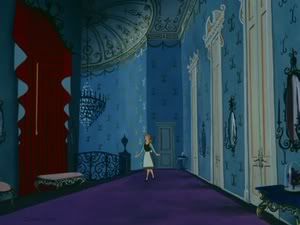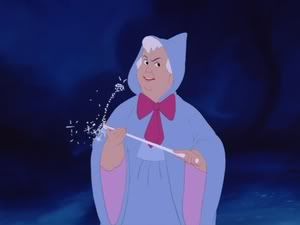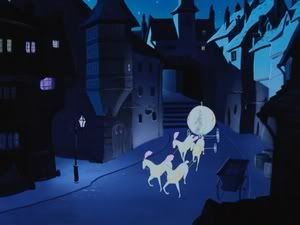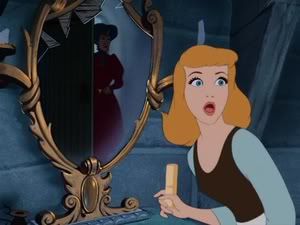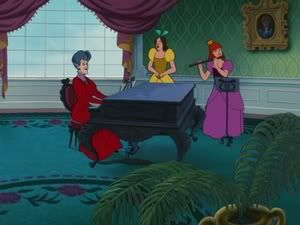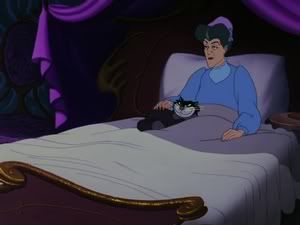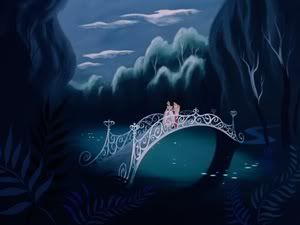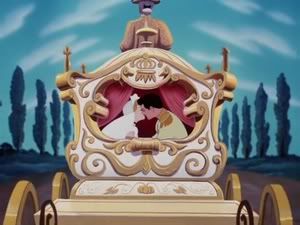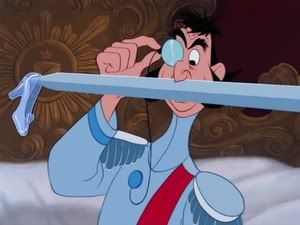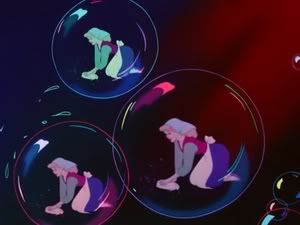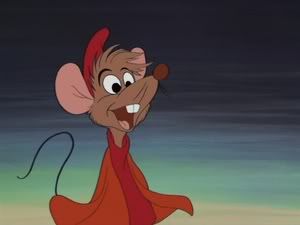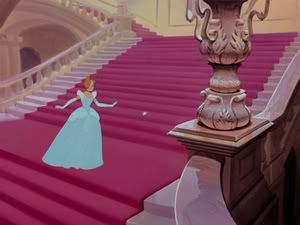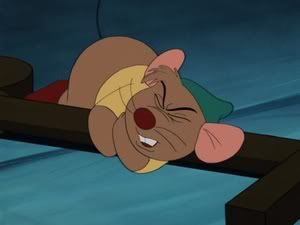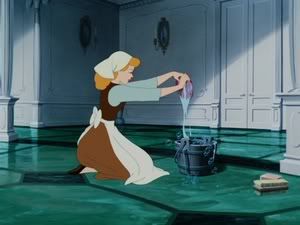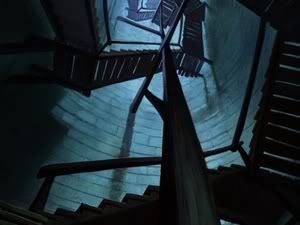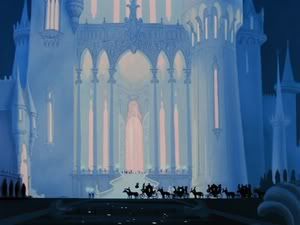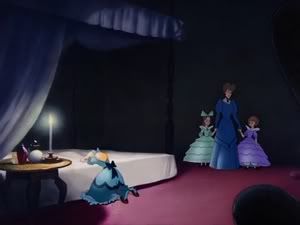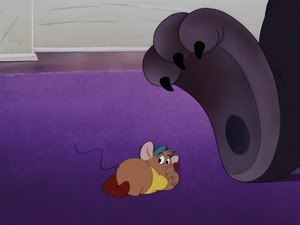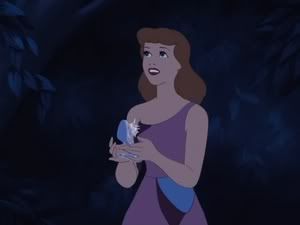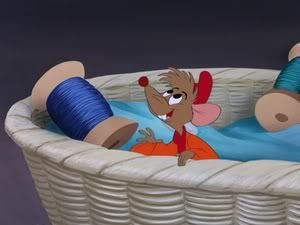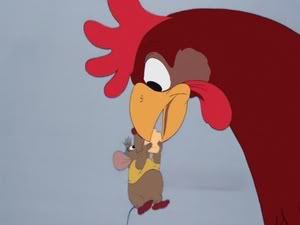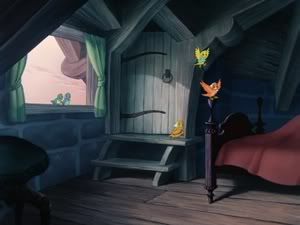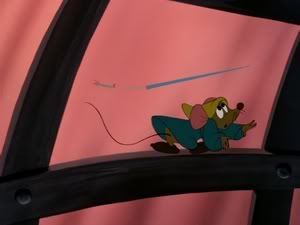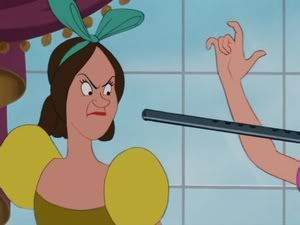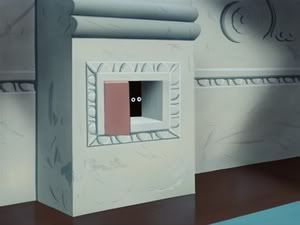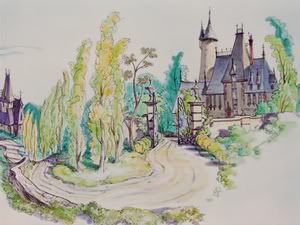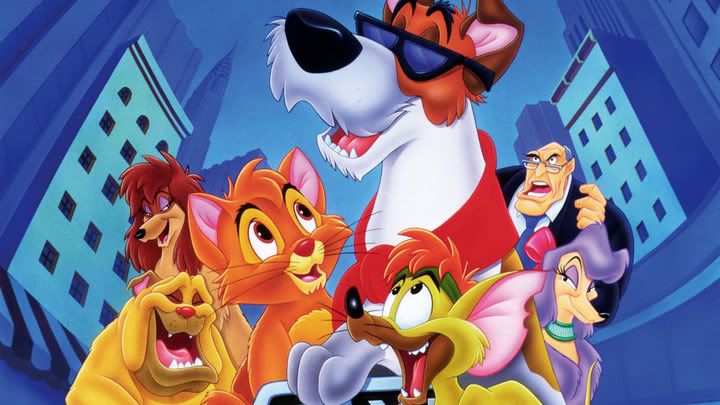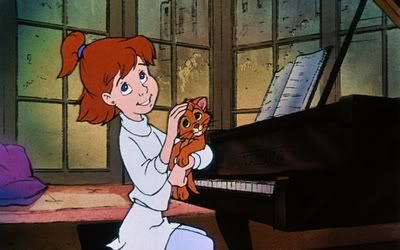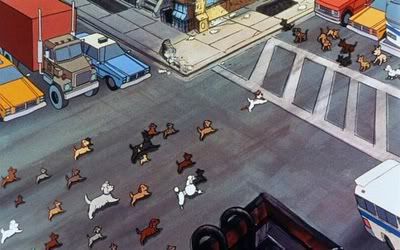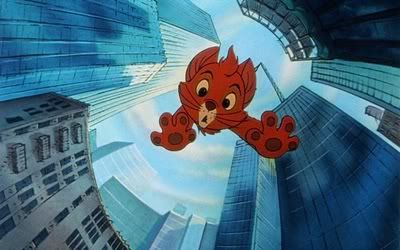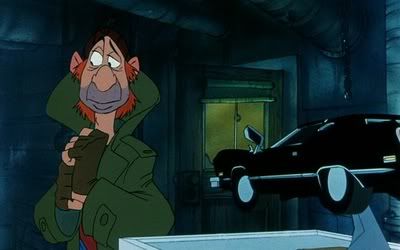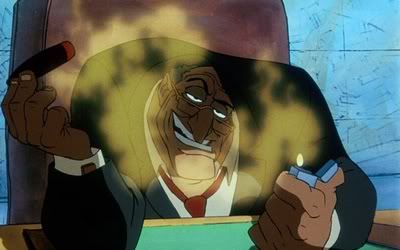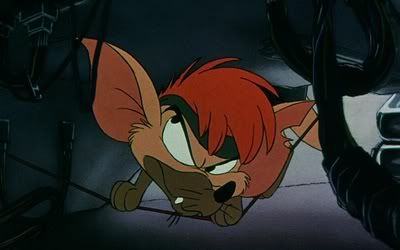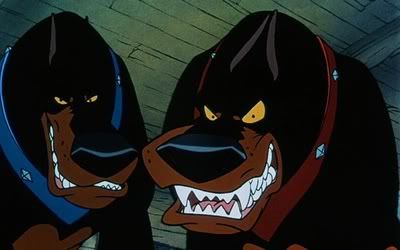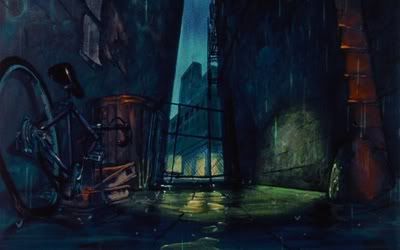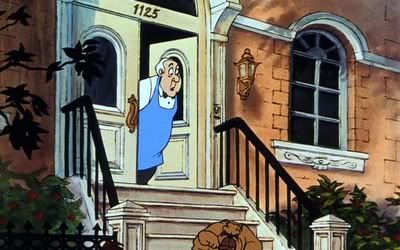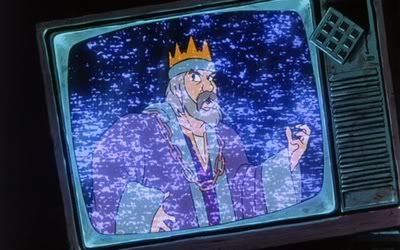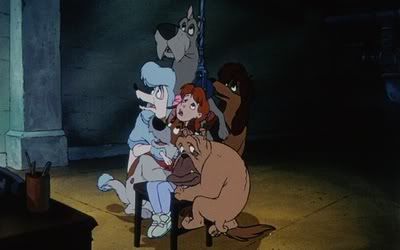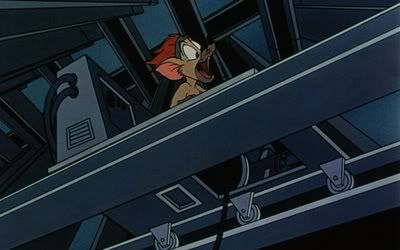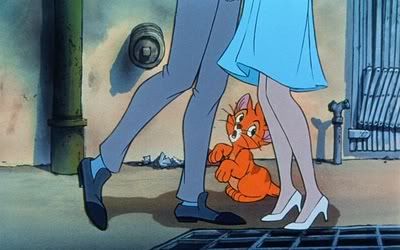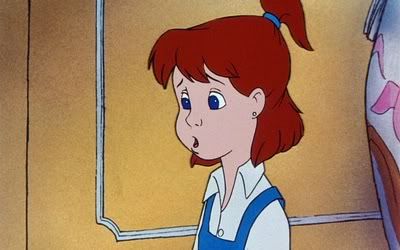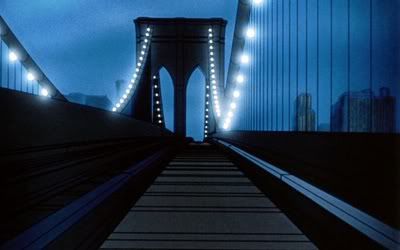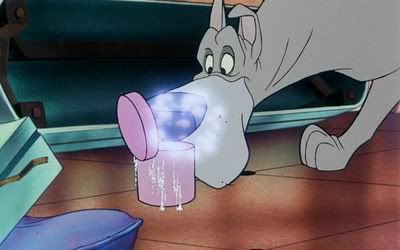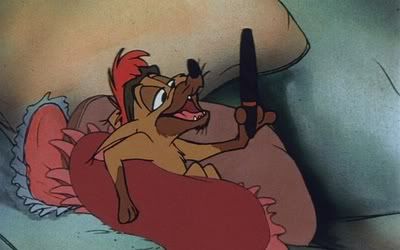Animated Feature Spotlight #2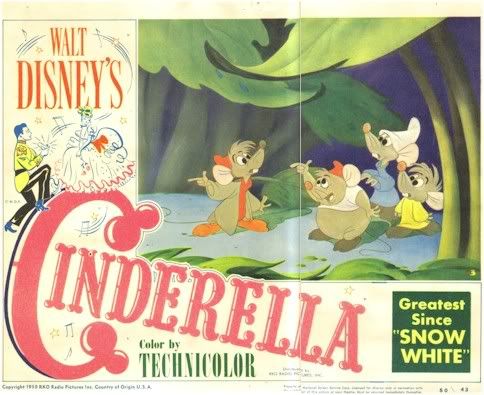
Cinderella(1950 / duration: 1 hour, 14 minutes)
★★½(
ALL IMAGES BELOW ARE ENLARGEABLE, except one -
CLICK THEM)
Synopsis (by "Luke Bonanno"):
"Loosely adapted from Frenchman Charles Perrault's late-17th century book, Cinderella tells the story of a spirited young lady who is reduced to being
an overworked servant at the hands of her relentlessly cruel stepmother and unpleasant stepsisters. News of a royal ball to which the attendance of all local eligible bachelorettes is sought gives Cinderella hope for a happy evening out and maybe more, for it is being thrown to find a handsome prince a suitable wife. But stepmother Lady Tremaine sees to it that only her daughters by birth, Anastasia and Drizella, go with the prospect of catching the prince's eye. Until, that is, the Fairy Godmother shows up, works a little magic, transforms Cindy's shredded dress into an elegant gown, and whisks her off to the dance. Despite having a lovely night of waltzing with a charming stranger, the fact that the magic will wear off at midnight forces Cinderella to exit in a hurry, thus separating her from her newfound love and leaving only a glass slipper behind. I'm sure you know this much and the rest, and chances are you know it from Walt Disney's widely-seen and adored retelling.
"Observations (mine):
The 50's truly were, to Disney, a fabulous decade. The reason why is clearly because their great success following 1937's
Snow White and the Seven Dwarfs was cut short due to the public's outright rejection of
Fantasia combined with World War II cutting off the European market- they just weren't able to get their new films overseas. So they had to rely on what would make America happy. America didn't like
Pinocchio or
Bambi much more than
Fantasia, either. This was beyond bad- it nearly destroyed the studio. In a way, were it not for
Dumbo, which was just successful enough to keep the studio afloat for the package-film years (1945-1949) - because the U.S. military weren't barely paying Disney for their propaganda shorts, there would have been no features after that.
I guess history teaches us that America can only take so much soft or girly fantasy before they decide they want an animal film about a little boy underdog. So following up
Dumbo - a very all-American fable with easy to swallow morality, seemingly lightweight action, and lots of heart-warmth, not to mention the novelty fun of circus conventions - with something as heavy and dramatic (and, let's face it- femme; have you ever heard of a boy with a name like that?) as
Bambi wasn't the greatest idea. But Disney were always experimenting. They never gave up on variety, since so many projects overlapped each other in development. Which is why I have a great, unexpressable fondness for the package film years which preceded
Cinderella, the film that everyone says saved Disney. And it's true.
Cinderella was a sure thing. The easiest bet the studio ever took. Which means two things. The first is that the film could be seen as the most vanilla (plain, boring, flat) in Disney's cannon. Is it? No way in hell (that honor belongs to either
Lady and the Tramp or
Beauty and the Beast- depending upon which era of Disney classics is your favorite: 1937-1959 or 1989-2009). The formula of the film depends on merging of all Disney's previous main elements. You'll notice we have a
Snow White here in the form of a beautiful, elligible young maiden who dreams of a handsome Prince falling in love with her. Then, there are the helpful mice friends straight out of
Dumbo who are always there when she needs them (and follow her around almost everywhere she goes).
The backgrounds are lush and breath-taking and elegant (I kinda credit
Bambi for this, there's a lot of brown and whitish-grays in both as well as pastel green). The musical sequences take us on a flight of fancy right out of reality, featuring gorgeous dissolves into bubbles and wafting watery scenery. That's clearly
Fantasia. There's a Wicked Stepmother who forces our heroine to work in rags, cleaning their large chateau-castle estate. As well as comedic hijinks featuring a small army of similar-looking dwarf creatures (the mice again). Both
Snow White. As for
Pinocchio, I might say the danger element that comes in every now and then. It's lowkey, but it's there just the same. Especially during the coach chase while the Duke screams, the creepy closeups of Lady Tremaine under shadows, and 3 or so Lucifer the Cat interludes.
Cinderella, like any Disney film, can clearly get-by without bringing a lot that's new to the table. In a way, the film really has one of Disney's most magical atmospheres. Highlighted by the dreamy "So This is Love" and "Oh, Sing Sweet Nightingale" sequences I referenced above. Easily two of the most stunning moments in Disney film history. The film has been seen by some as a dumb breeding tale. And it's hard to discount theories like those. My personal feeling on Disney is that their films are so broad, you can make whatever fantasy you want for yourself. And with that in mind,
Cinderella is a film that has a couple notable flaws. Its' structure as a fantasy dictates that it will bounce back and forth between an often obnoxious reality and a whole other world of dreams.
The latter is the one that makes the film enjoyable for me. A lot of people truly like the mice characters and I don't hate them or anything. But they
are strange. And very distracting. In fact, the film really seems to be more about them than the heroine of the title. Not only are they everywhere save for a single scene at the King's palace (where Cinderella has her famous ballroom dance encounter with Prince Charming), but since they outnumber her and could be considered cute by children, the Disney team try to develop characters and quirks for the lot of them. Doing that in the confines of a 75-minute animated film structure is kinda pointless. So there as underdeveloped as Cinderella is. And yeah, she is too. Which you can take to be good if you find the magic feeling vague, or bad if you come for storytelling.
The mice have silly habits and none of them are that amusing. On the boys' side, there are a pair of followers who look like twins. A fat little retarded one (with ensuing visual gags about how he's willing to risk his own life to get more food than the other, skinny mice and how he has to suck-in his large tummy to avoid being scaled by a drop of hot tea) named Gusgus who wants to fight huge cat, Lucifer (who is also fat and generally ugly- no surprise, Disney do have a nasty habit of trying to characterize villains with harmless features that nice normal people can have but are often picked on for). Then you have the chatterbox, Jaq. He's the least annoying and most heroic of the bunch. Which is clearly why he's the thinnest. No- seriously though, he's very likable. A
lot more so, in fact, than the hero of their 1953 classic,
Peter Pan (or his partner, Tinkerbell).
There are also some female mice, though since the film has so many female characters there isn't much for them to do but to "shoo! Shoo!" away the boy mice as Cinderella takes her morning shower (naked, of course, behind a folding screen). Perverts! And to enforce gender roles. While the mice all band together to make Cinderella's dress, Jaq (again this film's
Peter Pan - very chivalrous and dashing) volunteers to "do the sewing" with great enthusiasm. But this film's version of what I'd like to characterize as the patronizing nursing sister from the "Germans" episode of
Fawlty Towers stops him and tells him sewing is for women, assigning him instead the job of going out (of the cavernous attic crawlspaces they seem to live in) to hunt for supplies. (These guys don't seem to know the expression: get out of the cave!)
Unlike the males, all the female mice look and talk exactly the same- with only the colors on their outfits (all pastels) to differentiate between them. Now
that's sister solidarity. And this isn't the only example of somewhat confusing (or just plain wrong) Disney traditionalism present in the film. Which brings me to the film's Prince, who is built up in the scene of his ranting, raving, fossil of a father (the King, obviously) as a bit of a reckless wild child who's either left the nest to go find himself (beatnik) or still lives at the castle and frequently leaves to go out on his own (gay). "It's high-time the boy settled down!" screeches the idiotic old fool. This is clearly the story's way of trying to either rope him into a class he doesn't want to be a part of or force him into what is viewed as a heteronormative lifestyle.
Of course, with all these issues, the viewer is still given the freedom to not take them seriously. It would probably be hard in any period of American culture to make a fairy tale that would last through the ages and be considered socially relevant to future decades. Although, some might argue that even in 1950, these were primitive methods of telling a story. That leaves us to accept that what is most likely the truth is Walt himself was a bit of a traditionalist, racist, homophobe, but that he didn't mean any harm. That that's the way everyone was and there was pressure on him to believe certain things. (As for the claims that he turned people working for him over to the McCarthy lynch mob psychos... that would certainly make him look a lot worse. There would be no excuse for that- though this is all discussion for another time.)
Cinderella is not one of their best films. But like most of the classics, the questionable is more than outweighed by the attractive, entertaining, magical, and intriguing qualities. Things like goofily grinning animal sidekicks have been a Disney staple from the beginning and with all things considered, though
Snow White's bird and chipmunk friends never judged her, their involvement in the story and interaction with other characters improved somewhat by this time. Instead of just being an almost creepy army of smiling freaks, they all have a little pathos that determines they have personal space. For example, I mentioned Cinderella's shower scene earlier. In this film, you never get the impression that the mice would want to watch her. Not so in
Snow White. Everything was so communal there, no one had any privacy. Then, mix in the smiling faces and screwy eyes and you have a voyeuristic nightmare waiting to happen (ala- the glory hole scene in John Waters'
Cecil B. Demented).
Between the jaw-dropping animation and the magical feeling it inspires in most viewers, what Disney skates by on most is charm. I usually find charm in what is often considered by most not to be very charming at all. Colorful, playful darkness is my trade of choice. Disney deals a lot in this, shown in many of their films. Some viewers see Disney's darkness as a reputation of the forces of Satan and the underworld of Hell. That's way heavy. I believe instead, the animators viewed what they were doing more as art. And as a result, their films are experiences to sit and enjoy.
Snow White would have the edge over this film in terms of darkness. But,
Cinderella has perhaps the most cutting and hated villain in Disney history, as well (although I'm told the character Claude Frollo from 1996's
The Hunchback of Notre Dame has somewhat eclipsed her since the internet boom).
Lady Tremaine is the most personal villain of the classic era. She isn't a witch (though in one unforgettable moment, she is shown with glowing eyes of a different color) or a sorceress, she has no source of supernatural powers, and everything she does to Cinderella comes from a place of realistic, everyday human cruelty. Even though we don't see a lot during the movie of how her relationship was planted, there is more than one key moment where we see her trying to reduce Cinderella to tears and/or take away her only remaining hope. And given Cinderella's day-to-day life, throughout the movie she could be viewed as too optimistic anyway. While, respectfully, she is never treated like a lazy brat (I'll get to the stepsisters in a second), she's another Disney heroine given a supernatural kind streak.
Most importantly, however, she has a lot more sass than her
Disney Princess sisters Snow White, Aurora, and modern era models Ariel and Belle. Though her kindness is always kept in-check, she doesn't hesitate to be very firm when attending to the animals underneath her. This is part of the fantasy experience of Disney- in real life, we all know she'd be like Celie in
The Color Purple (only likely weeping with frizzed hair over hot stove) and have no control over Bruno, Lucifer, the mean chickens, etc. Her haggy stepsisters, Drusilla and Anastasia, are comic relief compared to the stepmother. And I've always loved them. Especially Anastasia (because she has the nicest moment, just that little "what's the matter with her?" with eyes wide open and face almost concerned-looking). Their little flute fight during their musical recital is hilarious.
Speaking of antagonists used as comic relief- did you know that the woman's voice doing narration at the beginning is the actress who went on to play Cruella DeVil in
101 Dalmatians? Oh, the woman playing Anastasia also is in
Dalmatians, as the voice who sings the "Kanine Krunchies" television jingle. Less entertaining than the bitchy, antagonistic women are the comedy team playing the royal hierachy in charge of running the kingdom where the story takes place. The King is definitely one of the biggest flaws of the movie (and will surely leave you longing for the much more big-hearted King Hubert from
Sleeping Beauty). The Duke ends up almost playing Iago to the King's Jafar. And even then, I
liked Iago and Jafar! The King is just such an unreasonable jerk in every way. A white-haired version of Mr. Banks from
Mary Poppins.
Cinderella the film is a push and pull the whole way through. But I think we all know that very few things in life are perfect. Watching Disney films will always be a perfect thing, though. It's almost impossible to put into words that magic they're capable of achieving. They WERE, that is. Things just ain't the same no more. But even that doesn't stop the old classics from working that voodoo they do so well. The music is charming, though only intermittently as otherworldly as some classic Disney films (my favorite moment: the awesome distortion that occurs while Lady Tremaine reads off The King's proclamation - listen for it). With the balance of female characters, it's nice to see them turn in a male as cool as Jaq and bitches as fun as Anatasia. And such a great villain. Oh...I forgot to mention the Fairy Godmother, didn't I? Oh well, you can't miss her. She's there. In all her chubby (sometimes viewed as nice when it's an older woman - though sometimes not, in cases such as
The Sword in the Stone and
Lady and the Tramp) glory.
